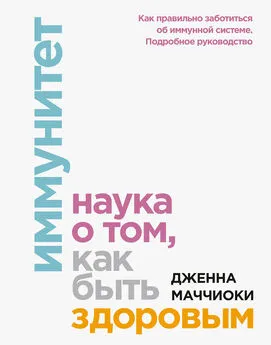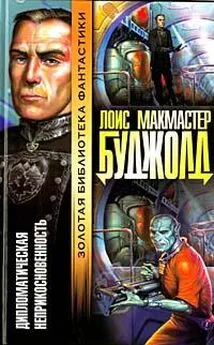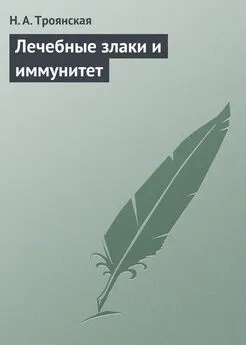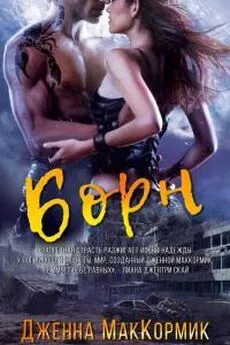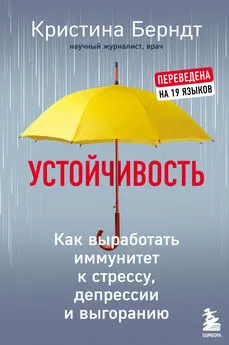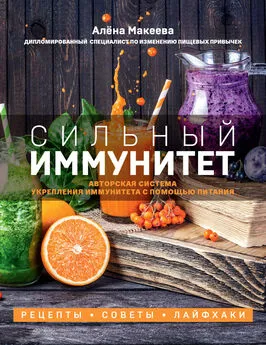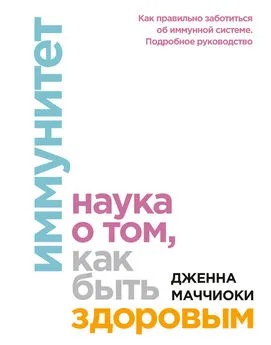Дженна Маччиоки - Иммунитет
- Название:Иммунитет
- Автор:
- Жанр:
- Издательство:Манн, Иванов и Фербер
- Год:2020
- Город:Москва
- ISBN:9785001691853
- Рейтинг:
- Избранное:Добавить в избранное
-
Отзывы:
-
Ваша оценка:
Дженна Маччиоки - Иммунитет краткое содержание
Иммунитет - читать онлайн бесплатно ознакомительный отрывок
Интервал:
Закладка:
242
Hespe, G. E. et al. (2016) ‘Exercise training improves obesity-related lymphatic dysfunction’, Journal of Physiology. Blackwell Publishing Ltd, 594(15), pp. 4267–4282. 10.1113/JP271757.
243
Zaccardi, F. et al. (2019) ‘Comparative Relevance of Physical Fitness and Adiposity on Life Expectancy: A UK Biobank Observational Study’, Mayo Clinic Proceedings. Elsevier Ltd, 94(6), pp. 985–994. 10.1016/j.mayocp.2018.10.029.
244
Barrett, B. et al. (2012) ‘Meditation or exercise for preventing acute respiratory infection: A randomized controlled trial’, Annals of Family Medicine. Annals of Family Medicine, Inc, 10(4), pp. 337–346. 10.1370/afm.1376.
245
Nieman, D. C. et al. (2005) ‘Immune response to a 30-minute walk’, Medicine and Science in Sports and Exercise, 37(1), pp. 57–62. 10.1249/01.MSS.0000149808.38194.21.
246
Pascoe, A. R., Fiatarone Singh, M. A. and Edwards, K. M. (2014) ‘The effects of exercise on vaccination responses: A review of chronic and acute exercise interventions in humans’, Brain, Behavior, and Immunity. Academic Press Inc., pp. 33–41. 10.1016/j.bbi.2013.10.003.
247
Edwards, K. M. et al. (2006) ‘Acute stress exposure prior to influenza vaccination enhances antibody response in women’, Brain, Behavior, and Immunity, 20(2), pp. 159–168. 10.1016/j.bbi.2005.07.001.
248
Edwards, K. M. et al. (2007) ‘Eccentric exercise as an adjuvant to influenza vaccination in humans’, Brain, Behavior, and Immunity, 21(2), pp. 209–217. 10.1016/j.bbi.2006.04.158.
249
Pedersen, L. et al. (2016) ‘Voluntary running suppresses tumor growth through epinephrine- and IL-6-dependent NK cell mobilization and redistribution’, Cell Metabolism. Cell Press, 23(3), pp. 554–562. 10.1016/j.cmet.2016.01.011.
250
Campbell, J. P. and Turner, J. E. (2018) ‘Debunking the myth of exercise-induced immune suppression: Redefining the impact of exercise on immunological health across the lifespan’, Frontiers in Immunology. Frontiers Media S.A. 10.3389/fimmu.2018.00648.
251
Schafer, M. J. et al. (2016) ‘Exercise prevents diet-induced cellular senescence in adipose tissue’, Diabetes. American Diabetes Association Inc., 65(6), pp. 1606–1615. 10.2337/db15-0291.
252
Cottam, M. A. et al. (2018) ‘Links between Immunologic Memory and Metabolic Cycling’, The Journal of Immunology. The American Association of Immunologists, 200(11), pp. 3681–3689. 10.4049/jimmunol.1701713.
253
Gleeson, M., McFarlin, B. and Flynn, M. (2006) ‘Exercise and toll-like receptors’, Exercise Immunology Review, pp. 34–53.
254
Duggal, N. A. et al. (2018) ‘Major features of immunesenescence, including reduced thymic output, are ameliorated by high levels of physical activity in adulthood’, Aging Cell, 17(2), p. e12750. 10.1111/acel.12750.
255
Bennett, J. A. and Winters-Stone, K. (2011) ‘Motivating older adults to exercise: what works?’, Age and Ageing, 40(2), pp. 148–149. 10.1093/ageing/afq182.
256
Zhao, M. et al. (2019) ‘Beneficial associations of low and large doses of leisure time physical activity with all-cause, cardiovascular disease and cancer mortality: A national cohort study of 88,140 US adults’, British Journal of Sports Medicine. BMJ Publishing Group, 53(22), pp. 1405–1411. 10.1136/bjsports-2018-099254.
257
Robinson, M. M. et al. (2017) ‘Enhanced Protein Translation Underlies Improved Metabolic and Physical Adaptations to Different Exercise Training Modes in Young and Old Humans’, Cell Metabolism. Cell Press, 25(3), pp. 581–592. 10.1016/j.cmet.2017.02.009.
258
Rall, L. C. et al. (1996) ‘Effects of progressive resistance training on immune response in aging and chronic inflammation’, Medicine and Science in Sports and Exercise. Lippincott Williams and Wilkins, 28(11), pp. 1356–1365. 10.1097/00005768-199611000-00003.
259
Piasecki, J. et al. (2019) ‘Comparison of Muscle Function, Bone Mineral Density and Body Composition of Early Starting and Later Starting Older Masters Athletes’, Frontiers in Physiology, 10. 10.3389/fphys.2019.01050.
260
Guthold, R. et al. (2018) ‘Worldwide trends in insufficient physical activity from 2001 to 2016: a pooled analysis of 358 population-based surveys with 1. 9 million participants’, The Lancet Global Health. Elsevier Ltd, 6(10), pp. e1077–e1086. 10.1016/S2214-109X(18)30357-7.
261
Паркран (от англ. parkrun) — бесплатные еженедельные мероприятия, которые проводятся сообществом волонтеров по всему миру: каждую субботу тысячи людей собираются в парках и бегут дистанцию пять километров. Прим. перев .
262
Vairo, G. L. et al. (2009) ‘Systematic Review of Efficacy for Manual Lymphatic Drainage Techniques in Sports Medicine and Rehabilitation: An Evidence-Based Practice Approach’, Journal of Manual & Manipulative Therapy. Informa UK Limited, 17(3), pp. 80E–89E. 10.1179/jmt.2009.17.3.80e.
263
Poppendieck, W. et al. (2016) ‘Massage and Performance Recovery: A Meta-Analytical Review’, Sports Medicine. Springer International Publishing, pp. 183–204. 10.1007/s40279-015-0420-x.
264
Abolins, S. et al. (2018) ‘The ecology of immune state in a wild mammal, Mus musculus domesticus’, PLOS Biology. Edited by D. Schneider, 16(4), p. e2003538. 10.1371/journal.pbio.2003538.
265
Fuss, J. et al. (2015) ‘A runner’s high depends on cannabinoid receptors in mice’, Proceedings of the National Academy of Sciences of the United States of America. National Academy of Sciences, 112(42), pp. 13105–13108. 10.1073/pnas.1514996112.
266
Dietrich, A. and McDaniel, W. F. (2004) ‘Endocannabinoids and exercise’, British Journal of Sports Medicine, pp. 536–541. 10.1136/bjsm.2004.011718.
267
Raichlen, D. A. et al. (2012) ‘Wired to run: Exercise-induced endocannabinoid signaling in humans and cursorial mammals with implications for the “runner’s high”’, Journal of Experimental Biology, 215(8), pp. 1331–1336. 10.1242/jeb.063677.
268
Mørch, H. and Pedersen, B. K. (1995) ‘βendorphin and the immune system — possible role in autoimmune diseases’, Autoimmunity. Informa Healthcare, 21(3), pp. 161–171. 10.3109/08916939509008013.
269
Schwarz, L. and Kindermann, W. (1992) ‘Changes in β-Endorphin Levels in Response to Aerobic and Anaerobic Exercise’, Sports Medicine: An International Journal of Applied Medicine and Science in Sport and Exercise, pp. 25–36. 10.2165/00007256-199213010-00003.
270
Kraemer, W. J. et al. (1992) ‘Acute hormonal responses in elite junior weightlifters’, International Journal of Sports Medicine, 13(2), pp. 103–109. 10.1055/s-2007-1021240.
271
IL-6 оказывает метаболические и противовоспалительные эффекты при физических нагрузках. Цитокиновый ответ при сокращении мышц специфичен. Прим. науч. ред.
272
Ekblom, B., Ekblom, Ö. and Malm, C. (2006) ‘Infectious episodes before and after a marathon race’, Scandinavian Journal of Medicine and Science in Sports, 16(4), pp. 287–293. 10.1111/j.1600–0838.2005.00490.x.
273
Fahlman, M., Engels, H. and Hall, H. (2017) ‘SIgA and Upper Respiratory Syndrome During a College Cross Country Season’, Sports Medicine International Open. Georg Thieme Verlag KG, 1(06), pp. E188–E194. 10.1055/s-0043-119090.
274
Cavaglieri, C. R. et al. (2011) ‘Immune parameters, symptoms of upper respiratory tract infections, and training-load indicators in volleyball athletes’, International Journal of General Medicine. Dove Medical Press Ltd., p. 837. 10.2147/ijgm.s24402.
275
Parker, S., Brukner, P. and Rosier, M. (1996) ‘Chronic fatigue syndrome and the athlete’, Sports Medicine, Training and Rehabilitation. Taylor and Francis Ltd., 6(4), pp. 269–278. 10.1080/15438629609512057.
276
Meeusen, R. et al. (2013) ‘Prevention, diagnosis, and treatment of the overtraining syndrome: Joint consensus statement of the European College of Sport Science and the American College of Sports Medicine’, Medicine and Science in Sports and Exercise, 45(1), pp. 186–205. 10.1249/MSS.0b013e318279a10a.
277
Costa, R. J. S. et al. (2017) ‘Systematic review: exercise-induced gastrointestinal syndrome-implications for health and intestinal disease’, Alimentary Pharmacology & Therapeutics, 46(3), pp. 246–265. 10.1111/apt.14157.
278
Spence, L. et al. (2007) ‘Incidence, etiology, and symptomatology of upper respiratory illness in elite athletes’, Medicine and Science in Sports and Exercise, 39(4), pp. 577–586. 10.1249/mss.0b013e31802e851a.
279
Например, когда ожидается встреча выпускников, к которой непременно нужно влезть в платье детского размера. Ради такой «благородной» цели многие после длительных месяцев сидения в офисе добровольно пробегают десятки километров на беговой дорожке или истязают себя в тренажерном зале дни напролет. Сила воли таких людей, конечно, восхищает, однако, увы, это не имеет ничего общего с иммунитетом и здоровьем. Прим. науч. ред.
280
Svendsen, I. S. et al. (2016) ‘Training-related and competition-related risk factors for respiratory tract and gastrointestinal infections in elite cross-country skiers’, British Journal of Sports Medicine. BMJ Publishing Group, 50(13), pp. 809–815. 10.1136/bjsports-2015-095398.
281
Cavaglieri, C. R. et al. (2011) ‘Immune parameters, symptoms of upper respiratory tract infections, and training-load indicators in volleyball athletes’, International Journal of General Medicine. Dove Medical Press Ltd., p. 837. 10.2147/ijgm.s24402.
282
Marqués-Jiménez, D. et al. (2016) ‘Are compression garments effective for the recovery of exercise-induced muscle damage? A systematic review with meta-analysis’, Physiology and Behavior. Elsevier Inc., pp. 133–148. 10.1016/j.physbeh.2015.10.027.
283
Costello, J. T. et al. (2015) ‘Whole-body cryotherapy (extreme cold air exposure) for preventing and treating muscle soreness after exercise in adults’, Cochrane Database of Systematic Reviews. 10.1002/14651858.CD010789.pub2.
Читать дальшеИнтервал:
Закладка:
